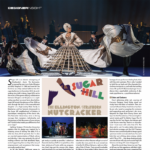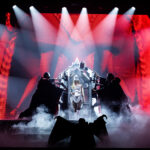
Superstar Karol G kicked off her 12-city U.S. leg of the Mañana Será Bonito stadium tour in August that ran through the end of September. The tour will continue in her hometown of Medellin, Colombia in December and move to Latin America next spring. The reggaetón and Latin trap artist won best new artist at the 2018 Latin Grammy Awards and continues to break records. She is currently the most watched artist of 2023 on YouTube with over 990 million views this year alone. Karol G also posted the highest grossing North American tour of all time by a Latin female artist and ranked on Pollstar’s Top 10 most successful music tours in the world with her previous $trip Love Tour. Production Designer Travis Shirley, of Blank Wall Creative collaborated with Lighting Designer Ignacio “Iggy” Rosenberg, of Lightswitch, and both generously shared some design insights about their collaboration on the Mañana Será Bonito stadium tour.
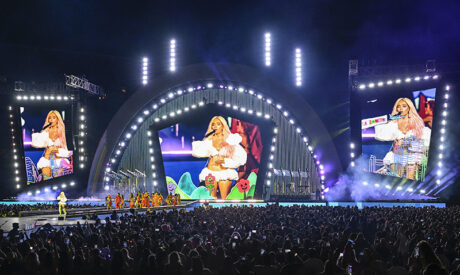
TRAVIS SHIRLEY
Production Designer
How long have you been working with Karol G?
Karol’s managment team brought me in to design and produce her Coachella performance in 2022. Karol and I instantly connected creatively and were able to break production boundaries that are inherent at Coachella. I think we really produced a Hell of a show. From that stemmed the $trip Love Tour, which was her first headlining arena tour. We got to know each other a lot more creatively and she’s literally a dream client for me. She is someone I’m very fortunate to now call a friend. She’s extremely intuitive and aware of what is going on with the production. I always say when I’m meeting with potential clients, and clients, that I do my best work when I’m in a collaborative environment with them, it brings out the best of us.
Tell us about your design for the Mañana Será Bonito tour.
The original concept was centered around doing two or three night one-offs at the Estadio Hiram Bithorn in Puerto Rico. That was never meant to be a tour. The show that’s on the road now, was actually designed to be a Karol G Music Festival, Mañana Será Bonito in Puerto Rico. Creatively, we knew we wanted that design to evoke a music festival feeling. We knew we wanted the rainbow and evoke the literal meaning of Mañana Será Bonito, which means ‘tomorrow will be beautiful’. There’s lots of her album imagery that’s heavily influenced with rainbows, and bespoke emoji-type graphics. The design stemmed from the vision to bring the album to life and we naturally landed on giant arch, which was pseudo-inspired by the Hollywood Bowl, but more so it really came from the idea of a giant rainbow. Therein lies the whole core of the design.
There are a lot of stadium tours and music festivals out right now and while that’s so great for our industry, at the end of the day you’re somewhat limited in what you can do production-wise with a lot of these required to use promoter stock, standard, festival-style stages. Playing in an open-air stadium, you’re basically performing within a black box at the end of the stadium. We wanted to break that mold, so we came up with the arch concept and really populating it with this custom low-res video screen that we had Screenworks make for us. We wanted to do something that was different. If you look back at some of the U2 and the Rolling Stones stadium shows, from the 90s, you saw the stage design of their production. It wasn’t necessarily just putting a production on within a stage of a black box or building a giant video screen. It was really important that we wanted to have a stage design that filled the stadium in Puerto Rico, especially since it was not meant to be a tour. Due to the success of Karol’s career, and the continued success of her Mañana Será Bonito album, her management team reached out and said, ‘What we have to do to take this production on the road?’
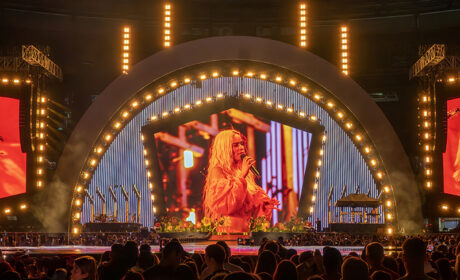
So, how did you make this production tourable?
There were a lot of production stipulations for the Puerto Rico show that wouldn’t necessarily be tour friendly. For instance, we built a lot of scaffolding to give us the backbone of the arch. Then when management wanted to take the production on tour, we had to rethink how do we take that arch that was specifically designed to be for a one-off show and make it tourable. After extensive research, I reached out to a few staging companies that have giant tents. The backbone of the arch now has a fascia on it; that’s just one bay of those mega tents that you see at the Coachella festival. Myself, along with Karol’s Production Manager Roly Garbalosa, thought, ‘That this could be the way to give us our arch and provide us some rigging, while also giving us some capacity to do what we need to do’. We have two sets of these arches that bebop around, essentially, that’s the ‘steel’ of the show. Meaning rather than advancing a traditional stage, or having a steel package go up, we’re advancing these arches that pop up. We then come in and populate it with the touring production. We had SGPS ShowRig build a projection surface fascia piece on the arches, so they appear like a completely bespoke staging structure. The arch is made from an aluminum structure with a piece of matte white material that allows us to project onto it. We have a series of eight projectors at front of house that are very, very precisely aligned during every load-in to give us the intensity we need for the projection. I think without that projection, the arch would not pop the way that it does.
From that point, we’re able to put the rest of production in. Obviously, Iggy [LD Rosenberg] did a great job on his light selection and how he programmed the show. Honestly, there were only so many places to put lighting and production due to the limited availability of structure, just the nature of that arch. So, yeah, the arch is really the backbone of the entire design. In addition, I wanted to populate that and fill that, so we reached out to Screenworks to populate the arch with a very low-res LED video product. Then in front of that, we have a higher definition screen in the middle of the stage. That lets us do a lot of very cool mixed media looks of different resolutions of content between the projection, the low res, and the high-res screens. We’re getting a multitude of different imagery, which I think really lends itself to taking this to the next level in terms of content.
The side screens are non-standard in terms of shape as well, correct?
Yes, we needed to extend the design to have some other adorning video elements, so I came up with this unique perspective video screen. A standard video screen just didn’t seem to fit the mold of what we were doing. Plus, I wanted to bring a little bit more of an energized festival-style, theme park-inspired video surface to accompany the arch, which is how we ended up with the uniquely shaped side screens. We built those and then built some fascias around them. Iggy was then able to populate lights all around those screens as well. I think we ended up with a really interesting production design, certainly one that looks like a totally custom one. We really wanted to avoid the black box nature of the stage and I think we ended up with something that’s quite unique.
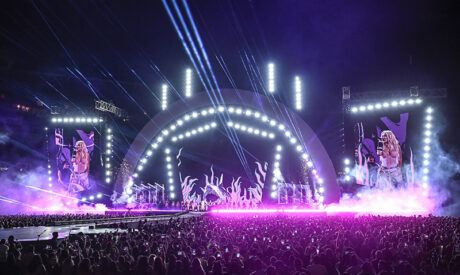
Talk a bit about the story arc of the show.
Working with Karol, when I presented her the design, we agreed that we needed to tell a story and that we would break the show up into four acts. We created the story of a mermaid named ‘Karolina,’ who obviously is Karol. The mermaid was trapped in this frozen world. She dealt with the danger of a shark, explored the land, rode to the clouds, and then eventually ended up in Mañana Será Bonito land. We identified each act with a specific, notable prop for each, for instance the first act was a giant inflatable mermaid.
Each of the four acts is representative of where the mermaid has landed. There are different landscapes that we created between the frozen mermaid inflatable on stage and the frozen icebergs. From there, the mermaid breaks free of that, but now she had to deal with the dangers of a shark. She conquers the shark and rides the shark out of that land. We crafted video content to accessorize that, and we made a 40’ diameter metallic shark that comes out of the video screen. The video screen opens, and this giant shark comes forward with Karol on top of it as if she’s commanding the shark what to do. As the show progresses, the shark goes away, and now Karolina, the mermaid, breaks free of the ocean and has flown to the clouds. We enter the ‘cloud act’ and to symbolize that, we decided to put Karol on a custom-made golf cart-style cloud. It was a cloud built around a work vehicle chassis that drove down the runway with her perched above this cloud.
As act three closes, we’re in Mañana Será Bonito land. Here we have giant inflatable flowers. A lot of the original album artwork—that initally inspired us to build this show in the first place—makes its first appearance in the last act of the show. We literally built this beautiful world of flowers, butterflies, rainbows, and more. It’s a pretty complex production. I feel that the story and the design work really well in supporting the show Karol wanted to achieve.
How was the vendors’ support for this tour?
All of the vendors did an outstanding job. We did something that hasn’t really been done in this capacity, with the show having been designed to be a one-off, then for a couple of days of touring, to a full-on world tour—this show’s going to stadiums next year in South America and then Europe will follow. So as this transitioned into a full world tour the vendors and the crew did an amazing job of pivoting. They all took in the changes as they came and made the adjustments needed to make this as operational as it is, because it’s certainly not a walk in the park. It’s a very, very big, aggressive show. I hope everyone is proud of it and their work, because I certainly am proud of this show and their contributions.
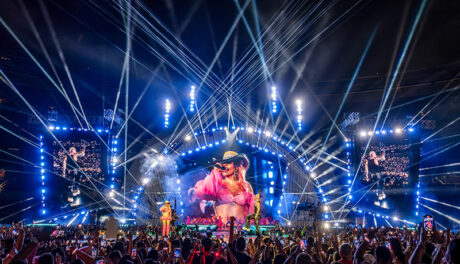
IGNACIO “IGGY” ROSENBERG
Lighting Designer
Talk about your work with Karol G.
I did Karol’s first show in 2021 and after two tours with her, we were invited back to design the lighting for her Mañana Sera Bonito stadium tour. It helps I’m originally from Argentina, so there’s a language and cultural bridge that helps the design process and transfer of ideas between us. The lighting design on this tour required a number of theme changes. Karol really knows what she wants to see and how her show needs to propel her energy into the crowd, so our goal is to support that with the lighting.
How did you use color in your design to support the story of the show?
I approached it by the different sections of the story. Two entire sections are limited to just a couple of shades of blue for one, and pink for the other. We only had a very small palette, so it was just blues, the entire first 10 songs or so. Then when she became the Bichota, which is her nickname, she went back to the purple hair and that kind of stuff, that entire section of the show was in pinks and magentas. The last section is where all the colors come in; it’s a very uplifting part of the show. It was a good challenge, this design, and I love that it forced us to work with timing, intensity, and shades. We knew we had to stay within these very, very regimented color choices. With different sections of the show occurring in a very small, defined palette, having accurate and discrete control of shades was so important. Having a difference between 25% and 35% saturation in magenta, for example, was key.
With all this color regimentation, how did that affect your cueing for the show?
There are a lot of cues; there are hundreds and hundreds of cues per song. Because it is reggaetón it’s a very dynamic style of music, but it has the same beat in most songs. So, we have to work with what the vocals are doing, what the melodies are doing. We’re listening to what the bass is playing because that is how you can differentiate the songs, you can’t go from the beat because it’s the same beat. It’s the beat that defines the musical genre.
There are a LOT of strobes in the show. Talk about your use of them in your design.
Karol has a lot of input on the lighting design because she loves lighting and it’s a big part of our show for her. She’s very involved with what the lighting looks like, and she puts a lot of trust in me. For this show we have are a lot of strobe hits because Karol loves strobes. She knows she likes what I do, and when we have conversations, she’ll go, ‘let’s get more strobes’. She is the only artist I’ve ever worked with that just keeps asking me for more strobes, which is incredible and a whole lot of fun. She will watch when we previz and make some changes. During the tour, we get notes every night. So, she’s very hands-on with the show. She knows what she wants to see, and she sees everything. The first time we rang out the strobes, I thought we might blow the generator. We have over 250 strobes. It’s a very heavily cued show to follow any little hit that the music does.
We also have a lot of the GLP JDC1s hanging in vertical trussing on the delay towers. I tend to design thinking people attend an event, not necessarily just go see a show. Karol also wanted the audience to have the show around them, so the people all the way in the back of the venue get their own light show and Karol gets to see everyone when they’re lit up. It was a way of taking the intimacy of a smaller show and scaling it up to this stadium size. Other strobes are the [CHAUVET] Color STRIKE Ms, which are amazing; they’re incredibly bright, which is exactly what we needed. The fact that they are IP65 rated has been great. They don’t move at all during the show; we point them at 90° out into the audience. We run the white strobe at 60% and I run the color panels about 35% the entire show, until the last song where I bring them up to full because the last song is HUGE. Mostly, they run at a very low level and are still strobes and blinders.
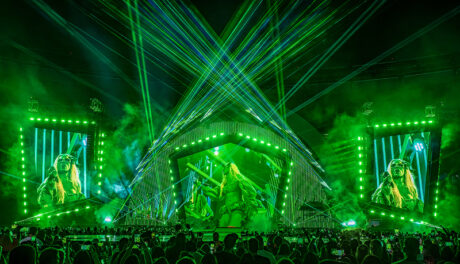
What are some of your other key gear choices?
The Ayrton Dominos, paired with the PRG GroundControl remote followspot system, were the highlight of the show, because I didn’t know what to expect. Originally, we were going to use another long throw fixture, but we couldn’t get them. We were slightly worried about intensity because the stage is massive. The runway is 120’ long. I did the math from the spot tower to the stage and the longest throw was over 270’ so we needed a light that could really push the level we needed. The Dominos have been phenomenal. They’ve been super solid, they look great, and they’re just monstrously bright. What also really helped me is that their zoom range is so big that when people were close to the stage, we weren’t pin spotting. We still had good control. There’s an acoustic number where Karol comes out in this giant cloud. We need to zoom out and pick up the entire cloud and they could do it. Also, they get small enough that they could shoot 270’ feet, so they’re really good. And, we wanted to be able to very finely meter everything for camera. We wanted to be able to have that control over smooth transitions and smooth fade outs. It is finally getting to the point where the moving heads are bright enough that we can start to replace 4,000W Xenon stadium followspots with a moving head; that really helps.
I used a lot of the [GLP] impression X5 IP Bars, which are all out in the open, lining the massive stage and runway thrust, which stretches 120’, so being IP rated was a must. They serve a few purposes—we needed them to be bright and versatile to act as strobes—we use them to blind the audience during transitions, so people don’t see the set pieces moving in and out, as well as creating volumetric effects. They also provide more subtle effects, like beautiful slow peels done with them that are really great to watch. Occasionally we flip them in and do some uplighting for two or three numbers, but they’re really used as edge-defining of the stage so people can see the shape. The zoom is a huge plus—we use that a lot to have these almost architectural shapes out into the air, which really pans out when you’re doing stadium shows at this size. From the top of a stadium, it really helps solidify what the stage looks like. And, in reverse they’re so bright that they can get to the top level of the stadiums, which is great.
The VL3600s were super solid, and they are also really bright. We don’t use any gobos in the show, and that’s on purpose. I never imagined this as a very heavy gobo show; it’s not that kind of music. So, being able to use the VL3600s as a beam light was really good. Also, I used a number of [GLP] impression X4 S units on the band risers. The plan was to give the band their own mini rig, and support cross camera shots, so there was always something in the background for the pit cameras to catch, rather than just trussing or the side of an LED screen.
How was the support of PRG as your lighting vendor?
PRG was great and really helped us out. Anthony “Looch” Ciampa was my PRG Account Executive and we prevized in Los Angeles and prepped out of PRG’s Las Vegas shop. I dumped a request for a stadium-worth of gear on them and they moved heaven and hell to find all that gear. They’ve been a great partner. Also, the schedule was really unbelievably tight, and they were able to really pull this together in a record amount of time. I’m a minimalist, so I would’ve liked to have the same sort of seven fixtures, and not 20 different kinds. They came back with most of the request intact, which was really great of them. Of course, some stuff had to change. We ran into some mechanical issues because of this giant arch and the lights keep changing angles as you get into the arch. Some of the fixtures we’re using, which are big and heavy, can’t be hung 90° anymore. The fixtures are getting too heavy. So, we had to come up with some different solutions and PRG was great at talking to the manufacturers about which lights we could hang at weird angles without issues. We’re using their new sACN nodes and when we had some issues in the beginning with them, PRG flew somebody out with a software update, ran through the test, and fixed all the issues. They’ve been super responsive. My programmer was PJ Carruth, who’s based in Burbank. Because the show is so big, and there’s so many strobes, we had to build a dedicated Depence machine to previz. We built this mega-computer so we could real-time visualize the over 200 strobes that are in the show.
Any final thoughts about working on Karol G’s Mañana Será Bonito stadium tour?
Obviously, it’s a testament to Karol, about how big she’s gotten, and how quickly. I will say she really is in-person just like she is on stage. She is the most genuine human. Her entire crew—it’s probably very easy to go and discount this Colombian, Latino crew—but they are all incredible people, and it all comes from the top down. It starts with the way Karol talks to us, and how she treats her crew. And, I will tell you she really has a crew that will jump over any flame to get the show going on for her. It really is a testament to how she is herself, and how she treats everyone, that this gigantic stadium record-breaking tour is manned mostly by an immigrant crew. Everybody’s from Colombia, from Argentina, etc. That I think is really great. It’s interesting to see how the world has changed in that respect and it’s a good thing to be part of.
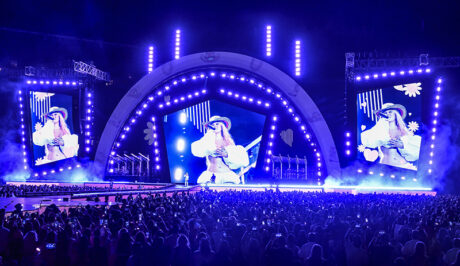
PRODUCTION TEAM
- Production Managers: Roly Garbalosa, Alejandro “Ado” Arius
- Tour Production Designer: Travis Shirley, Blank Wall Creative
- Lighting Designer/Lighting Director: Ignacio “Iggy” Rosenberg, Lightswitch
- Lighting Director: Rob Burns
- Lighting Programmers: PJ Carruth, Josh Lowenstein
- Lighting Crew Chiefs: Jeffrey (J.T.) McDonald, Ronald Beal
- Moving Light Technicians: Lawrence Colon, Sebastian Feliszak, Sarah Gaume, Travis Mitchell
- GroundControl Tech: Carl Dorbad
- Dimmer Technicians: Judie Gardner, Miles Brooks
- Lighting Climbers: James Higgins, Pablo Polanco Ibarra
- FOH Technician: Harrison Elmon May Jr.
- Lighting Technician: William Kennon, Kathryn Boyles, Phillip Eggestein
- Wristband Programmer: Shaheem Litchmore
VENDORS
- Lighting: PRG, Anthony “Looch” Ciampa
- Video: Screenworks NEP, Danny O’Brien, Nick O’Brien
- Staging & Scenic: SGPS ShowRig
- SFX: ImageSFX, Urbanlight Lasers
- Inflatables: Inflatable Design Works, Landmark Creations
- Props: Show Effects, David Mendoza
- Wristbands: PixMob
GEAR
Lighting
- 110 Robe MegaPointe
- 56 Vari-Lite VL3600
- 32 Martin MAC Ultra Wash
- 8 Martin MAC Ultra Performance
- 50 GLP X4S
- 134 GLP X5 Bar IP
- 12 SGM G7 BeaSt
- 8 Ayrton Domino LT (with PRG GroundControl)
- 190 CHAUVET Color STRIKE M
- 48 GLP JDC1 Hybrid Strobe
- 13 TMB Solaris Flare Q+
- 2 Astera Titan Tube
- 22 Astera AX5
- 8 MDG theONE Atmospheric Generator
- 2 grandMA3 full-size
- 1 grandMA3 light
- 1 PRG GroundControl System

